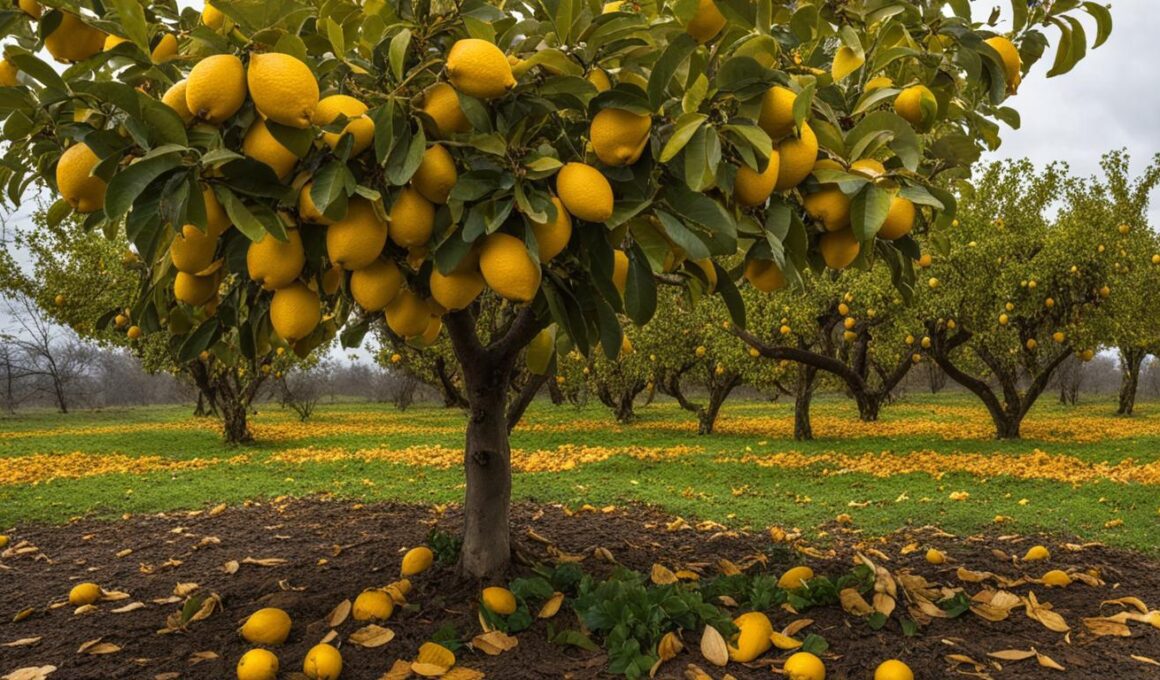Lemon trees are a beautiful addition to any garden or backyard, known for their vibrant foliage and delicious fruits. However, if you have a lemon tree, you may have noticed that it sometimes loses its leaves. This leaf drop can be concerning, but it is essential to understand whether it is a natural occurrence or a sign of an underlying issue.
Leaf drop in lemon trees can happen for several reasons. While some leaf loss during blossoming and fruit formation is normal, excessive leaf drop is not. Factors such as high heat, strong winds, nutrient deficiencies, dry or salty soils, and root rot can contribute to leaf drop in lemon trees.
So, how can you prevent and address leaf drop in your lemon tree? It starts with providing proper care and considering the tree’s environment. By understanding the causes of leaf drop and implementing the right strategies, you can promote leaf regrowth and maintain the overall health of your citrus tree.
In this article, we will explore the common causes of leaf drop in lemon trees and provide you with helpful tips to prevent and address this issue. So, let’s dive in and learn how to keep your lemon tree thriving and full of lush green leaves.
Causes of Leaf Drop in Lemon Trees
Leaf drop in lemon trees can be caused by various factors. One of the main culprits is dramatic changes in temperature. Lemon trees that are suddenly exposed to significantly warmer conditions can become stressed, leading to leaf drop. It’s important to ensure that your lemon tree is located in an area with consistent temperatures and protected from extreme heat.
Improper watering practices can also contribute to leaf drop. Overwatering or underwatering your lemon tree can disrupt its delicate balance and cause the leaves to wilt and fall off. It’s essential to maintain a regular watering schedule and monitor the moisture levels of the soil. Avoid letting the soil become overly dry or waterlogged.
Poor ventilation can negatively impact the health of your lemon tree and result in leaf drop. If the tree is placed in an area with inadequate airflow, it may not receive the necessary oxygen and nutrients it needs to thrive. Additionally, placing the tree near central heating sources can create a drier environment, further exacerbating leaf drop.
Insufficient light exposure is another common cause of leaf loss in lemon trees. These citrus trees require a substantial amount of sunlight to produce and maintain healthy foliage. If your lemon tree is not receiving enough light, it may respond by dropping its leaves. Ensure that your tree is located in a spot that receives adequate sunlight throughout the day.
Identifying the Underlying Issue
Understanding the potential causes of leaf drop in lemon trees is the first step in identifying the underlying issue. By assessing the temperature conditions, evaluating your watering practices, improving ventilation, and ensuring proper light exposure, you can take the appropriate measures to address leaf drop and promote the health of your lemon tree.
Tips for Preventing Leaf Drop in Lemon Trees
To prevent leaf drop in your lemon trees, it is crucial to provide proper care and create a suitable environment for these citrus beauties. By following some key tips, you can help maintain the health and vitality of your lemon tree and minimize leaf drop.
1. Temperature:
Extreme temperature changes can stress lemon trees and lead to leaf drop. Ensure your lemon tree is placed in an area with consistent temperatures and protection from harsh weather conditions.
2. Watering:
Follow a regular watering schedule to keep the soil moist but not waterlogged. Use room temperature water for irrigation to prevent any shocks to the tree.
3. Ventilation:
Proper ventilation is essential for lemon trees. Ensure good air circulation around the tree and avoid placing it near central heating sources, which can negatively impact its health and contribute to leaf drop.
4. Light Exposure:
Lemon trees thrive in full sunlight, so choose a location that receives sufficient natural light throughout the day. This will promote healthy leaf growth and minimize leaf drop.
5. Feeding:
Regular feeding with citrus fertilizer is vital for providing the necessary nutrients for healthy leaf growth. Follow the recommended feeding instructions to ensure optimal nutrition for your lemon tree and minimize leaf drop.
By implementing these tips into your lemon tree care routine, you can help prevent leaf drop and ensure your lemon tree remains healthy and vibrant. Remember, a little extra care goes a long way in maintaining the beauty and productivity of your citrus tree!
Conclusion
Experiencing leaf drop in lemon trees is common during certain stages, such as blossoming and fruit formation. However, if you notice excessive leaf drop, it could be a sign of underlying issues that require attention. Understanding the causes of leaf drop, such as temperature changes, improper watering, poor ventilation, and inadequate light exposure, is essential in maintaining the health and vitality of your citrus trees.
To prevent or minimize leaf drop, it is crucial to implement proper care practices. Ensure your lemon tree is exposed to consistent temperatures and protected from extreme weather conditions. Follow a regular watering schedule, providing moist but not waterlogged soil. Adequate ventilation and keeping the tree away from central heating sources are also important in preventing leaf drop. Additionally, choose a location that receives ample sunlight throughout the day.
Furthermore, regular feeding with citrus fertilizer will supply your lemon tree with the necessary nutrients for robust leaf growth and overall health. By following these care tips, your lemon tree will thrive, maintain its beautiful foliage, and contribute to the overall appeal of your garden or landscape.
Are Yellow Leaves on a Peach Tree Similar to Lemon Tree Leaf Loss?
Yes, peach tree leaves yellowing signal can look similar to lemon tree leaf loss. Both can be caused by various factors like nutrient deficiencies, disease, or stress. It’s important to properly identify the cause to effectively address the issue and promote healthy tree growth.










